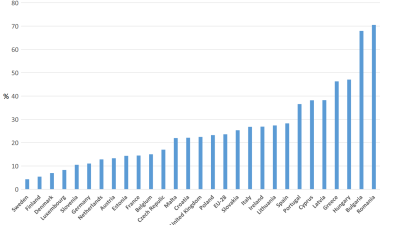by Professor Peter Taylor-Gooby, University of Kent
By 2017 the UK is set to have the lowest share of public spending among major capitalist economies, including the USA, as a result of the exceptionally harsh cuts in public spending currently planned. But is this really necessary?
The government has prioritised the reduction of public debt and is determined to keep extra taxation to the absolute minimum, resulting in a much tighter public expenditure target being imposed than other advanced capitalist countries. The consequence, according to the International Monetary Fund’s latest predictions, is that while before the 2008 financial crisis, the UK’s public expenditure as a percentage of GDP was in about the middle of the major capitalist economies, above the USA, Japan and Canada though below Germany, Italy, Sweden and France, the UK is heading swiftly to the bottom (see interactive graph below).
General government total expenditure as a proportion of GDP
Actual data to 2011 (USA actual data to 2010) then IMF estimates (darker background).
There is much speculation about why a relatively rich country, which experiences no difficulties in borrowing over long terms at low interest rates, should choose to adopt such unusual economic policies, particularly since such policies are now agreed by most commentators to be damaging to the national interest (Taylor-Gooby, 2012). While the government is determined to shrink public spending, it is maintaining spending on pensions, health and education. These are highly popular areas of spending and it would be electorally damaging to cut them. Welfare for the poor, by contrast, is being cut back sharply though this also appears to be popular.
The consequences of these policies for those on low income have been extensively analysed. The Institute for Fiscal Studies predicts an increase in poverty (by the standard 60 per cent median income poverty line) of the order of 0.8 million by 2015 and of 2.3 million by 2020. This increase will be concentrated among families with children and single people of working age (Brewer, 2011). The Resolution Foundation shows how job insecurity is increasing and wages stagnating, particularly at the bottom end (Brewer et al., 2012). Housing problems are growing steadily more pressing.
In the short term, the welfare state is under the most severe and sustained attack it has faced, with cuts much harsher than those of the 1980s. If one wants to be gloomy, one can point out that longer-term forecasts of public spending indicate that population ageing, staff costs in human services like health, social care and education, and rising aspirations mean that we will need to spend much more in these areas simply to stand still. These are the more popular areas of the welfare state. The implication is that the pressure to spend in these areas will be hard to resist, so that spending on pensions, health and education for the mass will be sustained. There will be extra pressures on unpopular benefits for the poor and unemployed, on social housing, and on family support. Bad news for inequality, and especially for women and children in low income families.
So what can be done to prevent the UK taking bottom place?
Two suggestions:
· Shifting the terms of the debate: welfare state spending is often divided between the popular mass services (pensions, healthcare, education), which distribute horizontally over people’s lifetimes and are highly valued, and the much less popular benefits, which redistribute from better to worse off (cash benefits for unemployed people, single parents and those on low wages). This ignores the changes in the way people live their lives and the growing risks and needs of the past three decades. Increasingly, the issues that many people confront are about managing work and family life, finding care for children and for frail relatives of reasonable quality that they can afford, getting access to good quality education and training, and finding and paying for decent housing.
These issues bridge the division between mass and minority services. They are not confined to low-income minorities but are shared across much of the population. They are not easily understood in terms of laziness or irresponsibility, and do not attract stigma. However, spending in these areas can help to address issues of poverty and inequality because it can help low income families get jobs and give better opportunities to their children.
Serious investment in childcare might turn out to be a real investment that pays an economic return by helping more people to work. It might also be electorally attractive. Similarly, housing reforms such as a land tax, rent controls and state investment in social housing might help enough people for such reforms to gain support. Education is popular and could expand to include training and retraining programmes of decent quality.
· Redefining welfare: many politicians see welfare as a ‘burden’ on the productive economy. This is misleading. Much social spending is indirectly productive, enabling the productive sector to operate effectively, and this needs to be made clear, as in the case of childcare and social care or education spending that enables people to work effectively. Similarly, much welfare is seen as damaging because it undermines the work ethic. This is incorrect: the problems of low wages that need to be supplemented to enable families to survive and of lack of opportunities to work are much more severe. New approaches to welfare could be developed that stress social contributions and expand the idea of entitlements as a right. One programme developed by Horton and Gregory proposes a return to a welfare system more firmly rooted in universalism and with a new system of national insurance that rebuilds the lost idea of entitlement (Horton and Gregory, 2009).
These ideas may seem utopian, given the scale of the pressures on welfare. A crisis is a turning point. There are indications of the possibility of a shift in public attitudes, as shown by the Occupy movement and associated political struggles. More broadly, public concerns about fair taxes and tax avoidance, childcare and education, and the quality of private sector provision in training and in health and social care are rising and can only get stronger. Never waste a good crisis.
References
Brewer, M., Browne, J. and Joyce, R. (2011) Child and Working-age Poverty from 2010 to 2020, London, Institute for Fiscal Studies. Also available online at http://www.ifs.org.uk/comms/comm121.pdf (accessed 12 November 2012).
Brewer, M., Gambin, L., Joyce, R. and Wilson, R. (2012) Who Gains from Growth?: Living Standards in 2020, London, Resolution Foundation. Also available online at http://www.resolutionfoundation.org/media/media/downloads/Who_Gains_from_Growth_2.pdf (accessed 12 November 2012).
Horton, T. and Gregory, J. (2009) The Solidarity Society, London, Fabian Society. Also available online at http://www.fabians.org.uk/publications/the-solidarity-society/ (accessed 12 November 2012).
Taylor-Gooby, P. (2012) ‘Root and branch restructuring to achieve major cuts: the social policy programme of the 2010 UK coalition government’, Social Policy and Administration, vol. 46, no. 1, pp. 61–82. Also available online at http://www.social-policy.org.uk/lincoln2011/Taylor-Gooby%20P4.pdf (accessed 12 November 2012).



 PSE:UK is a major collaboration between the University of Bristol, Heriot-Watt University, The Open University, Queen's University Belfast, University of Glasgow and the University of York working with the National Centre for Social Research and the Northern Ireland Statistics and Research Agency. ESRC Grant RES-060-25-0052.
PSE:UK is a major collaboration between the University of Bristol, Heriot-Watt University, The Open University, Queen's University Belfast, University of Glasgow and the University of York working with the National Centre for Social Research and the Northern Ireland Statistics and Research Agency. ESRC Grant RES-060-25-0052.






